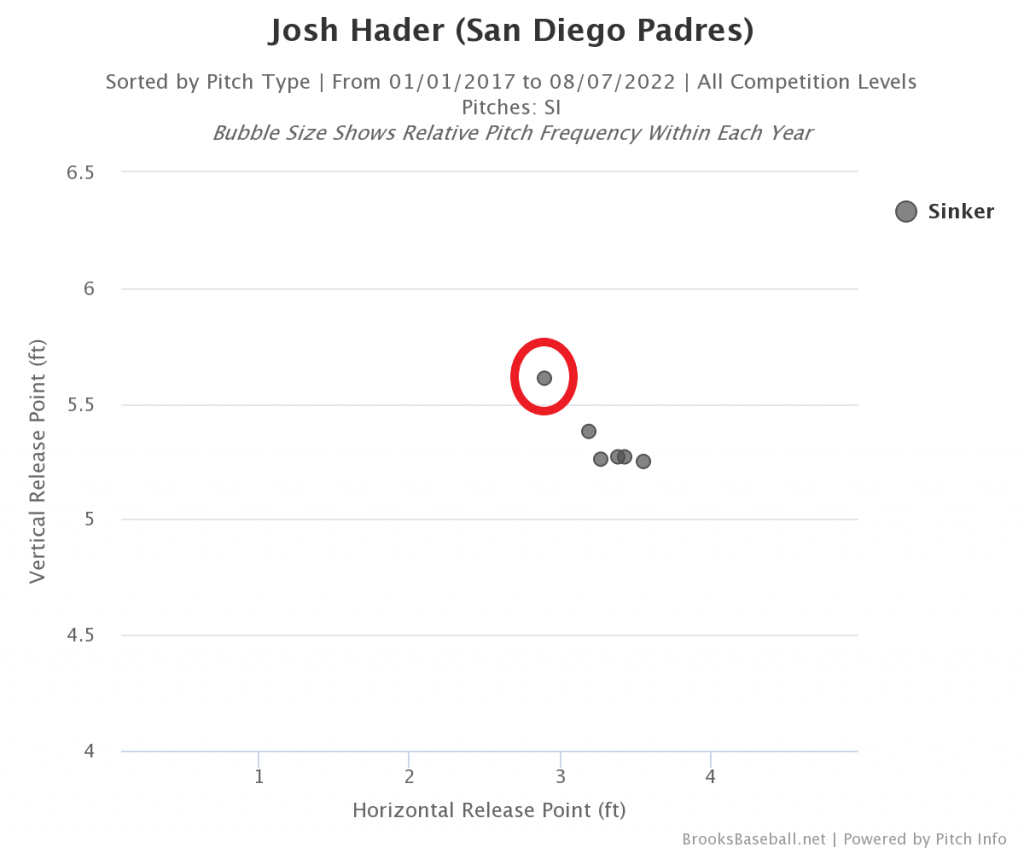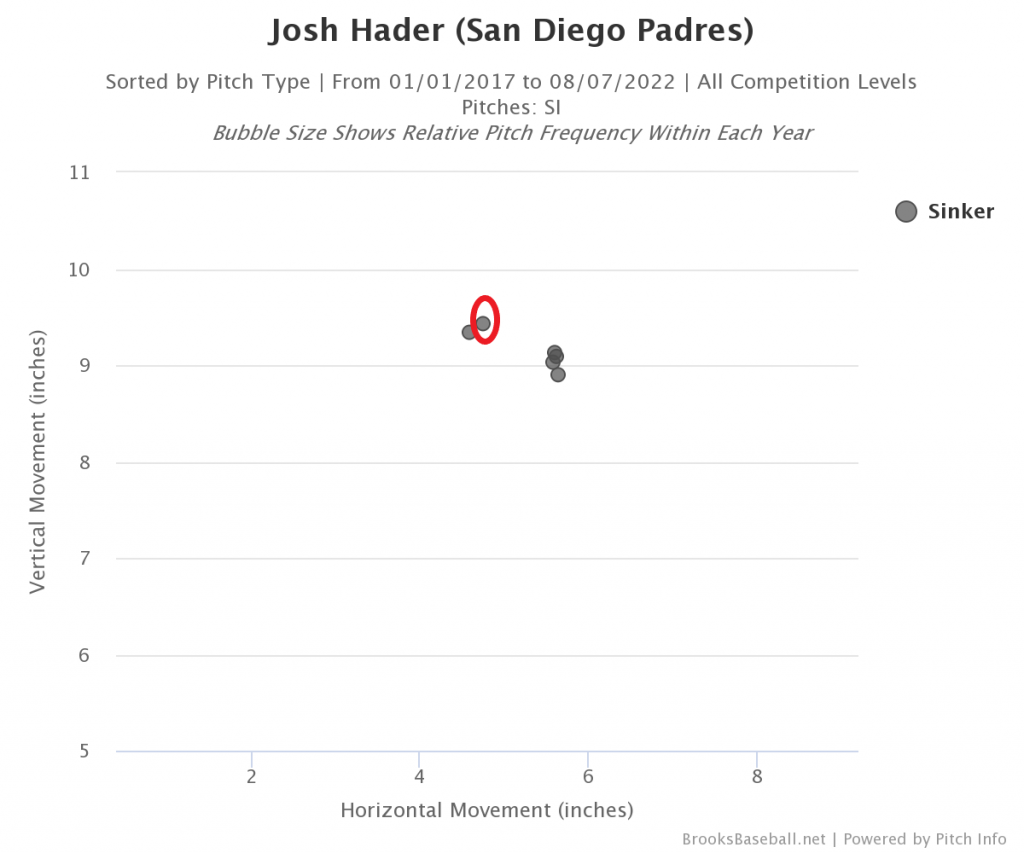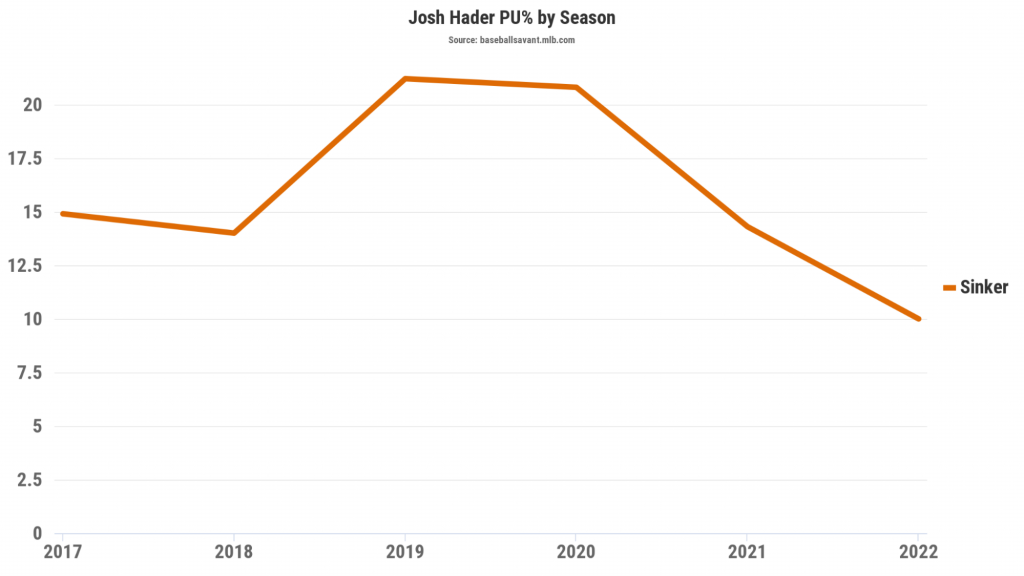
Perhaps the most surprising move before the trade deadline was that, in the midst of a likely postseason berth, the Brewers traded Josh Hader to the Padres in exchange for Taylor Rogers, Dinelson Lamet, and a couple prospects. Optically, that looked pretty bad, and within a few days, Lamet was designated for assignment, adding to the poor optics of the situation. I’m not here to rationalize things for the Brewers, but I do want to pose the argument that the Padres aren’t getting the Hader that people have grown accustomed to.
If you’ve been following Hader this year, then you’ll know that, mostly, he’s been very good. He’s been 30% better than league average according to DRA-, ranking 14th best in MLB, with one of the higher WARP totals of all relievers. The thing is, he hasn’t been characteristically good, with a July in which Hader surrendered as many home runs as he did walks, good (bad) for a 12.54 ERA on that month. The question is, why? Jay Jaffe has you covered there:
Much of the recent damage against Hader was done to his sinker, which in July was hit for a .345 average and .759 slugging percentage; the 10 hits and five extra-base hits he allowed during the month were more than he allowed via the pitch from April through June (four hits, three for extra bases). Hader has thrown the pitch faster this year than last, but he’s throwing it from a higher arm slot and getting less movement on it.
That’s basically an article, all consolidated into one paragraph. Hader’s sinker was good. Maybe not characteristically so, but good. Then, in July, something happened, where Hader was getting fewer whiffs on his sinker than in any month over his career, and with his highest slugging percentage ever too. Jaffe judiciously points out that Hader is throwing harder, but that his arm slot has risen, which has resulted in some of the least arm-side run he’s ever had.
It’s worth spending some time here, because Hader’s arm slot is everything. Consider his arm slots over the year, plotted by horizontal and vertical release point, with his 2022 release point circled in red:

For years, Hader has made his money releasing the ball around 5.25 feet above the ground, about 3.50 feet towards first base from the center of the pitching rubber. From 2017 to 2020, that made for one of the most unique release points in baseball, with only 11 pitchers releasing the ball closer to first base, and 11 pitchers releasing from a lower release point. An outlier release with strong pitch characteristics often begets positive results, and until now, Hader hasn’t had many hiccups, but this is looking like more than just a blip to me.
Let’s go further and look at Hader’s raw sinker movement, by horizontal movement and short-form vertical movement, by year, again, with his 2022 sinker circled in red:

Again, you’ll find that Hader’s sinker has changed significantly relative to previous years, with much more fastball ride—generally a good thing!—but much less arm-side movement. The difference here is that, this time, his 2017 sinker is close in proximity in terms of raw pitch movement, and yet it’s been a significantly inferior pitch. That hints at a lot, which I’ll get to in a moment.
One important consideration is that, as per usual, raw pitch movement doesn’t tell us everything, but especially with a pitcher like Hader. Consider his horizontal approach angle (HAA) and vertical approach angle (VAA) which show how Hader’s sinker has slowly deteriorated in pitch quality:
| VAA | HAA | |
| 2019 | -3.7° | 2.5° |
| 2020 | -3.6° | 2.5° |
| 2021 | -3.8° | 2.4° |
| 2022 | -4.1° | 2.6° |
If we were looking at Hader pre-VAA, pre-Statcast era, we would be in disbelief that he’s throwing harder, with more sinker ride, and yet his sinker is getting hit harder than ever. We might conclude that Hader is tipping his pitches, or maybe that the change in has made him less deceptive. There’s something to that last point, and, again, I’ll get to that momentarily, but clearly Hader’s sinker has begun entering the zone at a slightly steeper angle, which means the days of Hader having the flattest fastball in baseball are no longer. It’s certainly not drastic enough to make his sinker ineffective, but clearly lesser so.
So, Hader’s sinker has lost some of the flatness that make it special. So much is clear. But there’s another consideration here, one that still makes Hader something of a unicorn. From Lance Brozdowski:
You’ve probably never stopped to think about it, but it’s not an easy thing to throw a high-efficiency sinker that spins around 10:45 to 11:00 on a clock face from such a low arm slot. The video here makes it clear how Hader is able to do that: despite throwing from a low slot, he’s able to keep his wrist orientated vertically, which helps him create a vertical spin profile from a horizontally-oriented release. In other words, much like seam-shifted wake, that’s what makes Hader deceptive: he’s creating pitch movement that’s incongruent from what you’d expect from his arm slot.
Here’s a representative release point from Hader in 2020:

And then again, from 2022:

Hader still releases the ball with his wrist orientated vertically, which means his spin tilt, or spin direction, has remained about the same. But now that his arm slot has started to rise, the sinker isn’t as deceptive as it once was, because his expected spin direction from his release point has moved from about 9:30 to 10:30 on a clock face, which has begun to converge with his actual spin direction of 11:00. It’s clear that his sinker has become less deceptive because of this, so it’s not getting on hitters as well as it used to.
I can show how this is the case in two ways. One is that Hader is getting fewer whiffs than ever, something that Jaffe and I have made plenty clear. The other, though, is Hader isn’t getting as many pop-ups anymore. From Baseball Savant:

If a sinker moves more vertically than you’d expect based on release, odds are you’re going to swing under it, because it falls way less than you’d expect. That’s either going to result in a whiff—something that, again, is way down for Hader—or a pop-up or weakly hit fly ball. As you can see, Hader has been inducing fewer pop-ups than ever, and even though he still induces a fair amount, hitters are also squaring up the ball more than ever. That not only means harder hit balls, but also more balls put into play, which has translated to more barrels per plate appearances. The hard contact was palatable back when Hader was generating more whiffs than anyone in baseball. Now that those have gone away? He’s been more mortal than ever before.
Hader’s miserable July had been in the works for awhile. His release point has been creeping up since 2021, and now he’s finally suffering the consequences. If you’re looking for some optimism, I’m not sure I’ve got any to offer. It’s hard to imagine that Hader is ever the same without his old arm slot, and it doesn’t seem like he’s going to get back to it any time soon. Perhaps he’ll get something out of an altered grip? The Brewers may have traded their relief ace while in the thick of a playoff race, but maybe there’s reason to believe that Taylor Rogers ends up being the superior option to Josh Hader come October.
Thank you for reading
This is a free article. If you enjoyed it, consider subscribing to Baseball Prospectus. Subscriptions support ongoing public baseball research and analysis in an increasingly proprietary environment.
Subscribe now